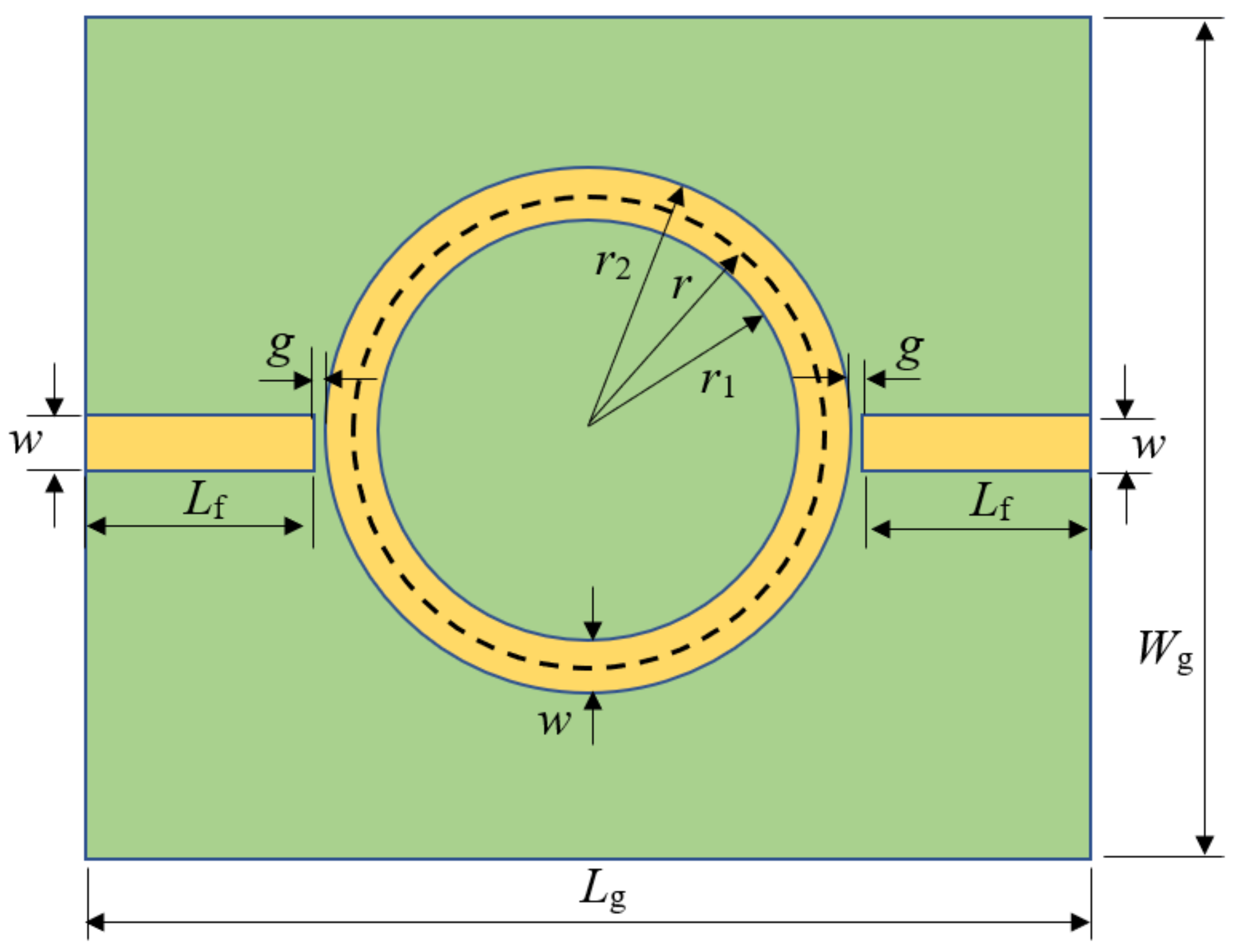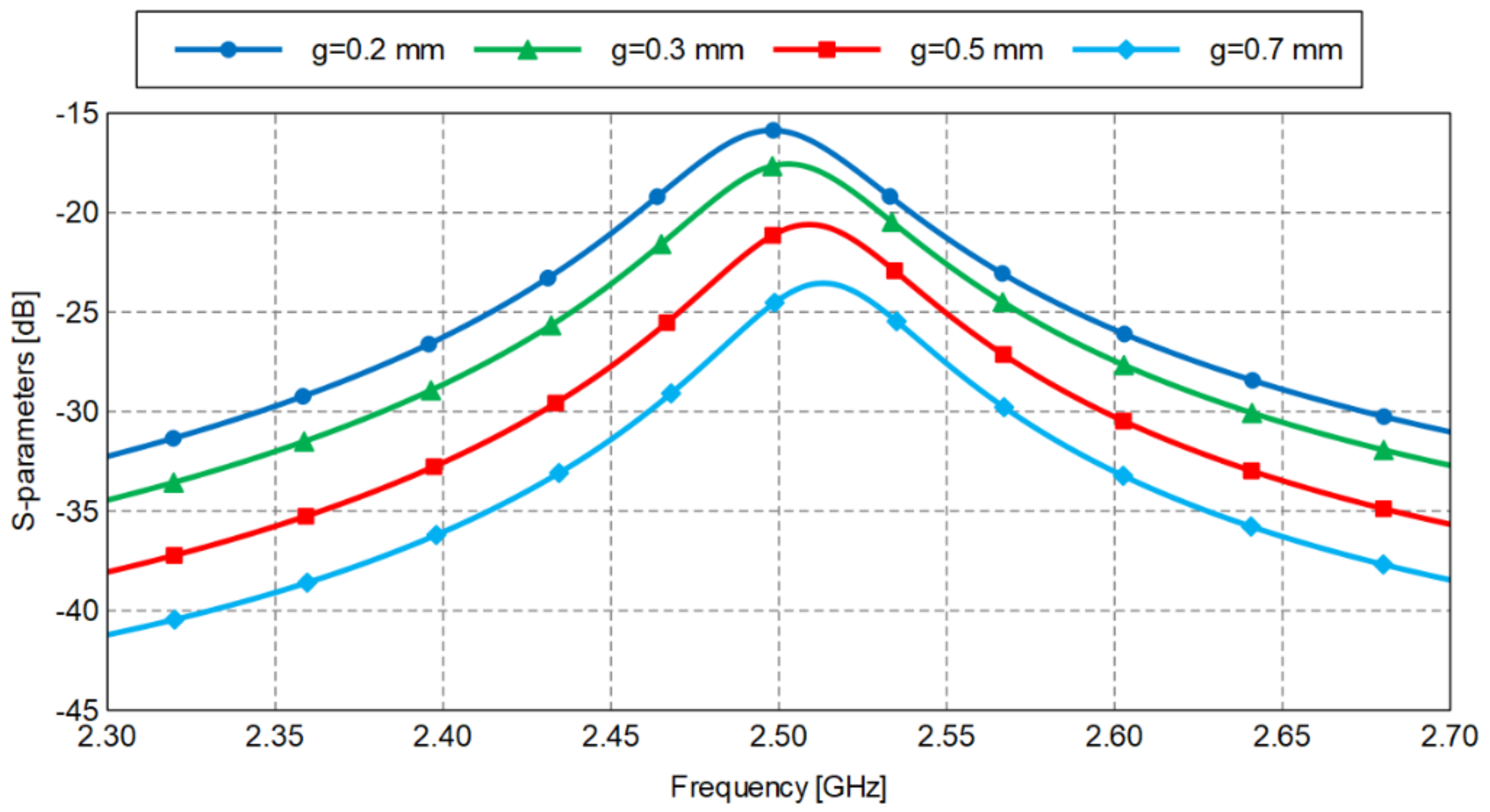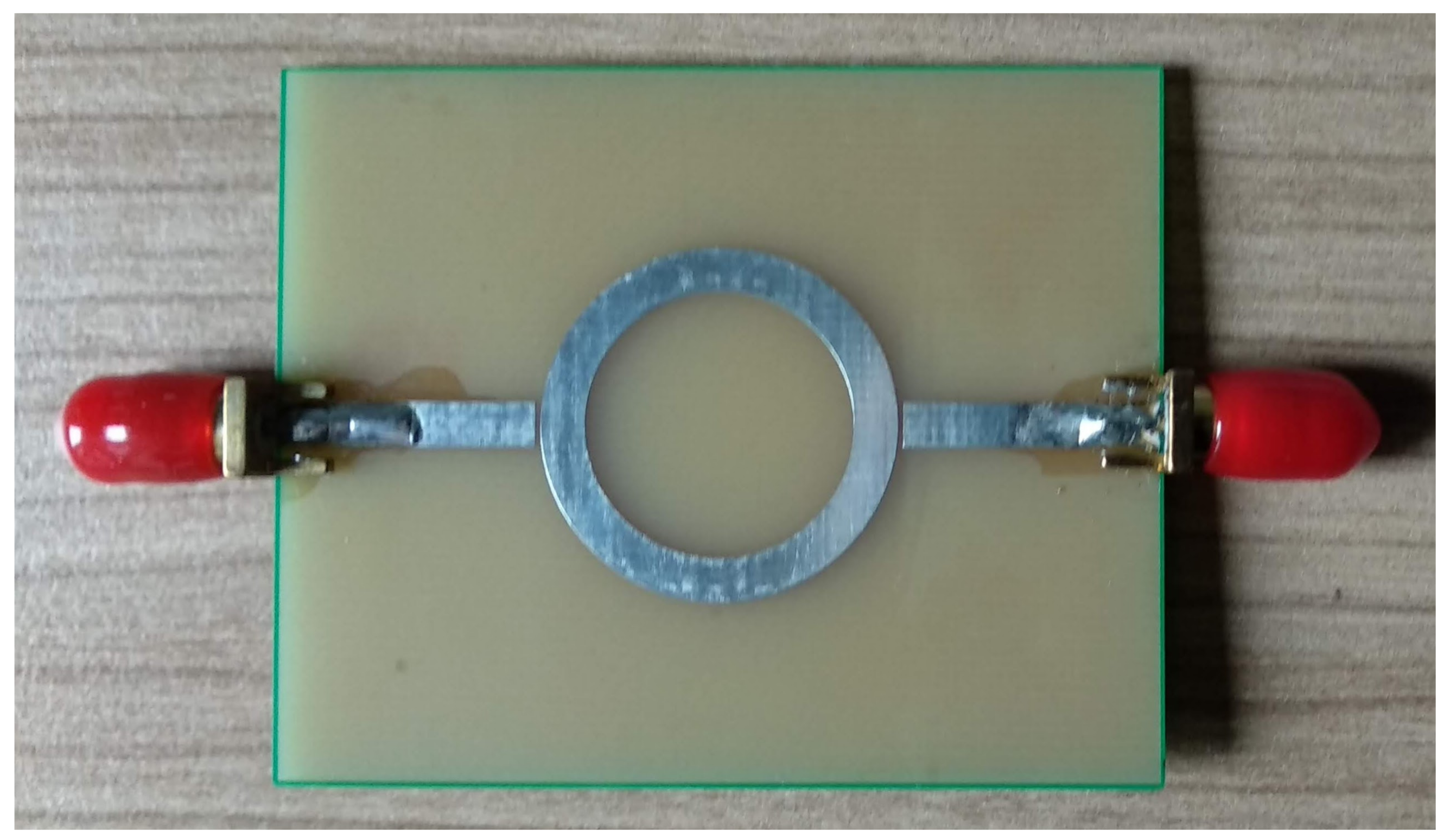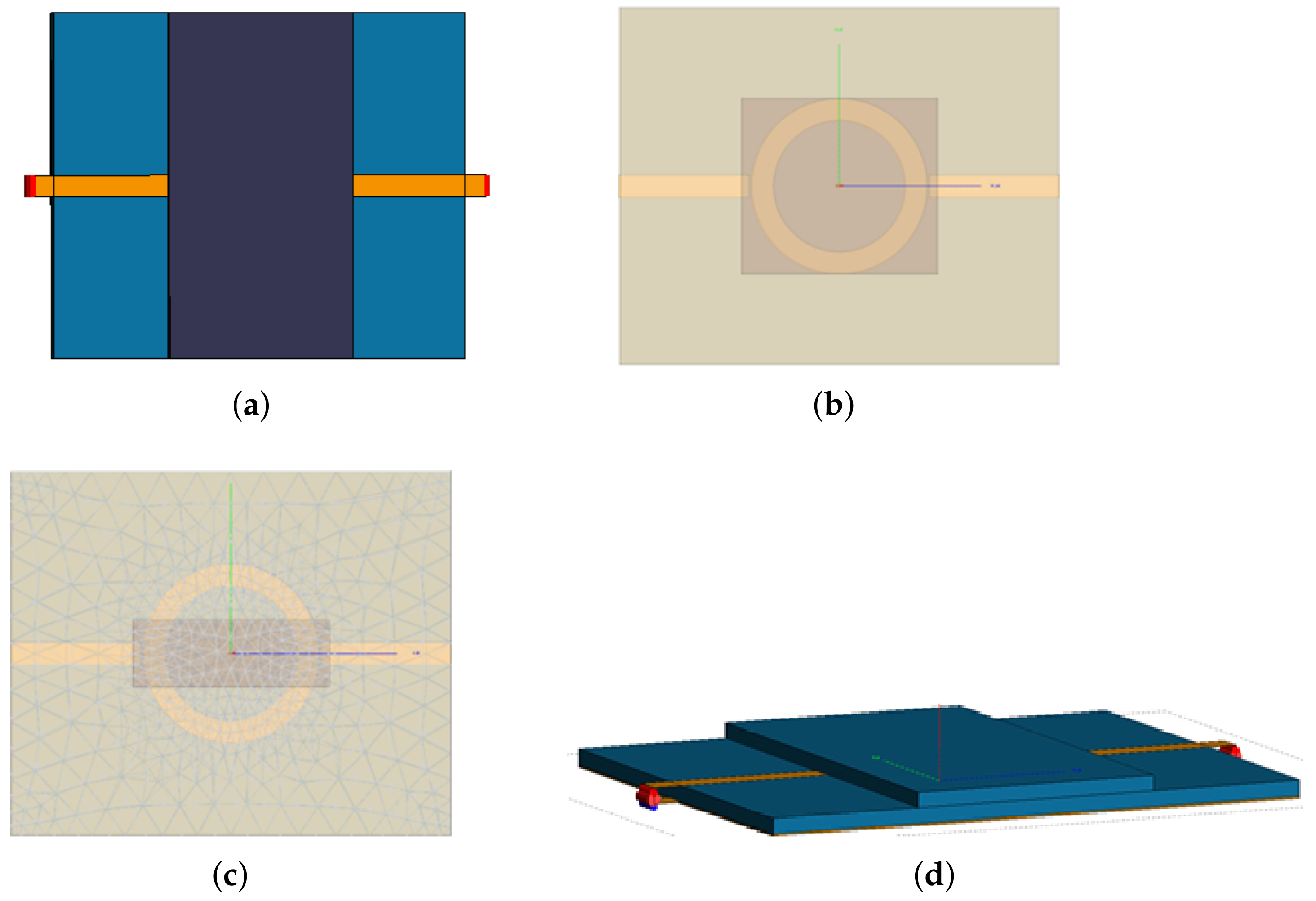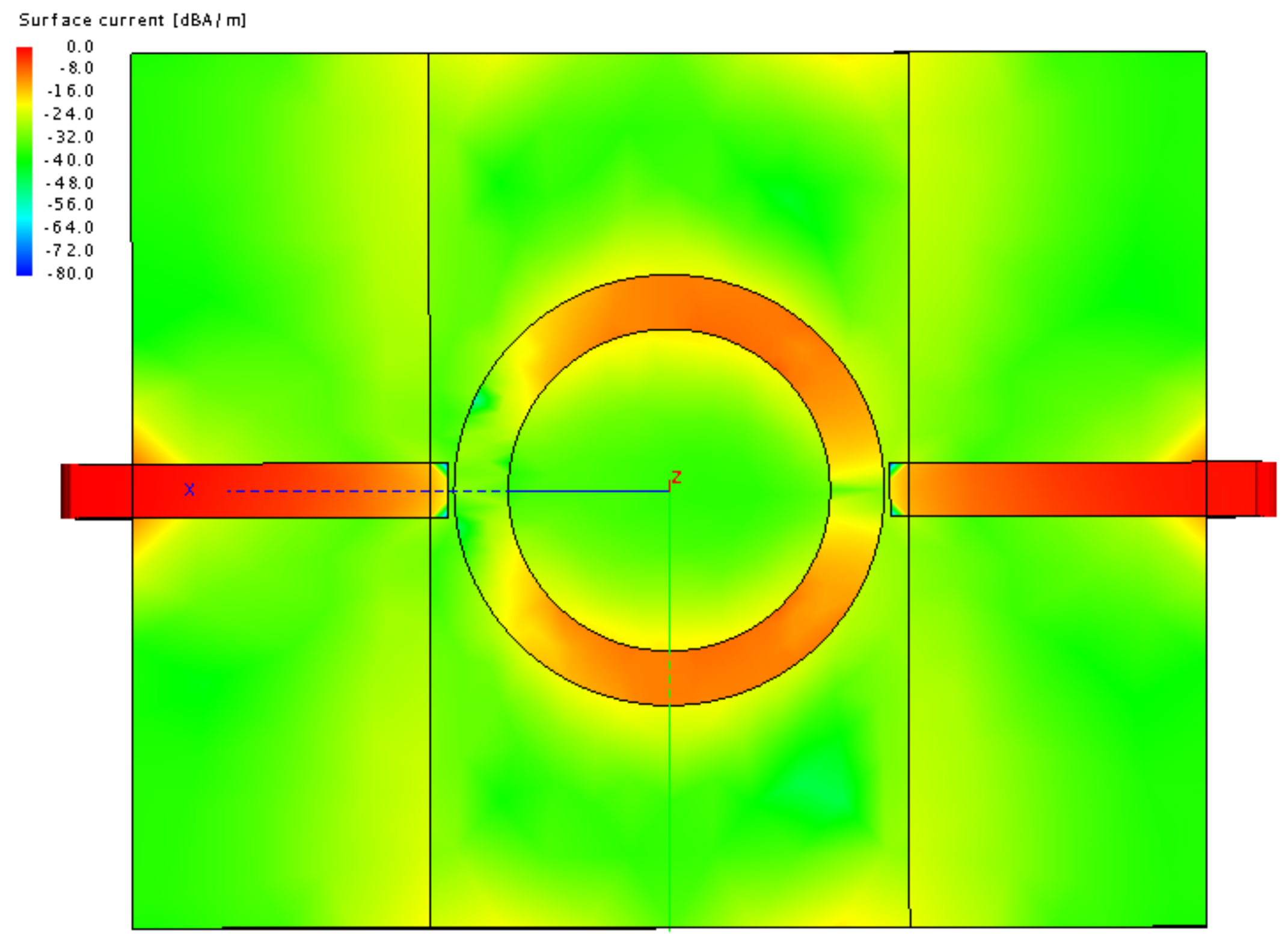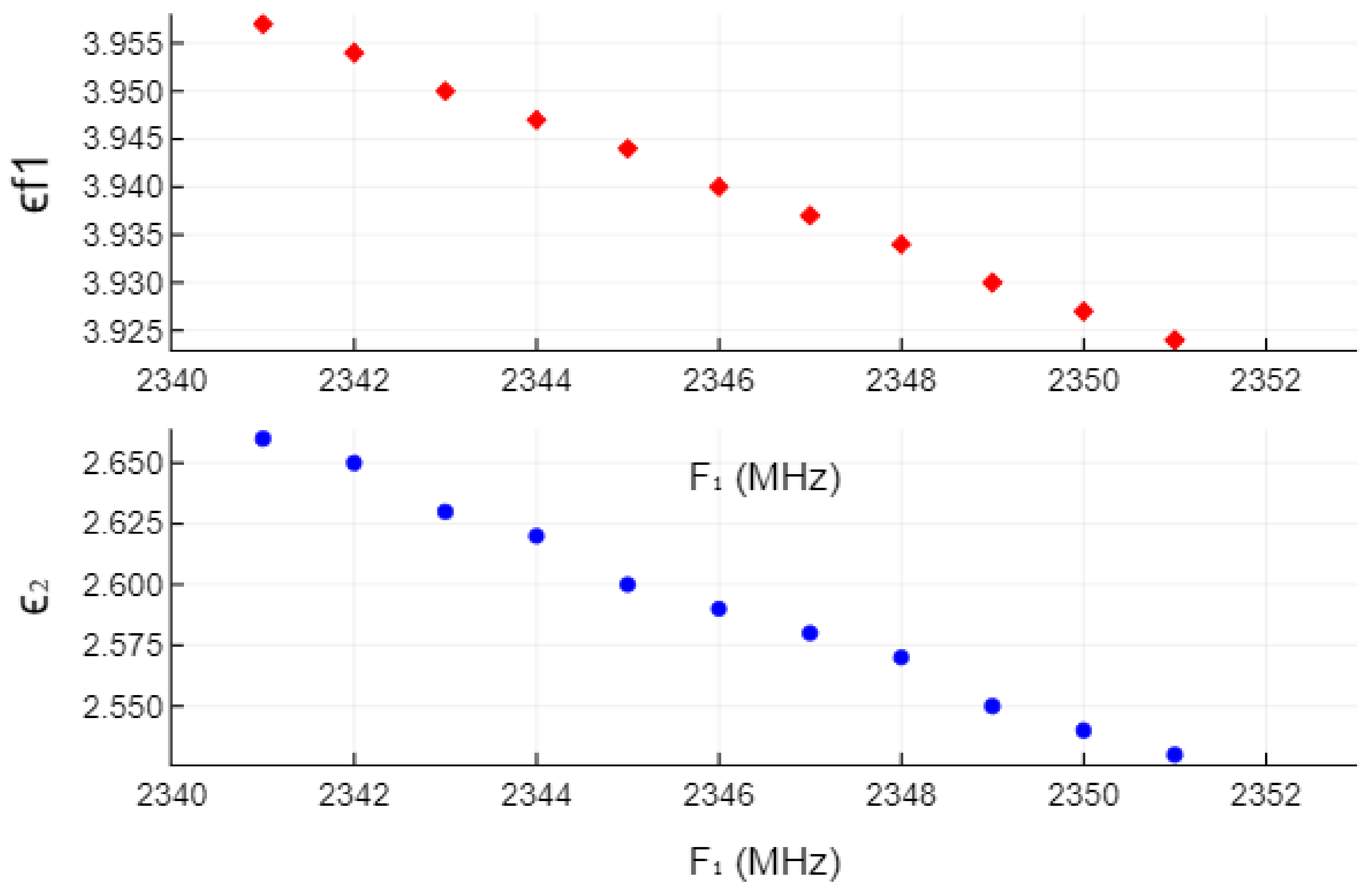1. Introduction
Relative permittivity of a material, , is an important parameter for the design of antennas and microwave circuits because it strongly affects the dimensions of the circuit and the resonant frequency. When industry-standard dielectrics are used in the circuit design, their characteristics, including the relative permittivity, are known from the manufacturers’ data sheets. Nowadays, however, modern designs can also include some nonstandard materials, such as various fabrics (to be used in wearable applications, for example), whose permittivity is typically not included in the manufacturer’s specification because that parameter historically had no significance for the textile industry. Not knowing the permittivity introduces a significant uncertainty to the circuit designer, and it is necessary to determine it for a successful circuit design.
Various methods with very distinct features have evolved in that sense [
1,
2,
3,
4]—those that can characterize the materials under test in a wide frequency range, as opposed to those that do it in a narrow frequency band, practically at a single frequency; those that are invasive for the sample under test, to those that are noninvasive for the sample; those that are more suitable for low-frequency range, as opposed to those that are more suitable for high frequencies; those that are suitable for low-loss dielectric and thin samples vs. those that are suitable for liquid materials more than for solid materials; those with a more complicated measurement apparatus vs. those with a relatively simple one; those that measure the unknown material in a way that the test circuit is built using that unknown material as the substrate layer of the microstrip circuit, as opposed to those methods that use the known substrate layer and test the unknown material by laying it over, or inserting it in, the measurement fixture. There is no universal or best method to cling to, but the choice of a method really depends on one’s particular needs and case.
Commercial test kits are quite expensive, some even being compatible only with vector network analyzers (VNA) of the test kit vendor [
5] or merely with some particular models of VNA and accompanying test fixtures (possibly of another vendor [
6]), whereas some other vendors offer compatibility of their test kit with a broader range of VNAs [
7], yet either of them offering only a conditional accuracy and prospect of getting accurate and trustworthy results due to the sensitivity of the measurement procedure to various tolerances. Facing these facts, a researcher with a limited budget may realize in a fairly short time that, for most practical purposes, it may be a sound option to build his own test circuit that will enable characterization of unknown dielectric materials.
In this work, it was desired to have a circuit that is simple to design and manufacture and, thus, cost-effective, while appropriate for characterization of thin, solid, and low-loss dielectrics. The frequency range of interest was below 6 GHz. More specifically, we aimed to use it at about 2.4 GHz. It is a single-frequency method, but that is not a penalizing factor due to the fact that permittivity changes little within a relatively wide frequency range and the test circuit can be designed and manufactured at a low cost for various single frequencies of interest. The particular circuit of our choosing was a microstrip ring resonator (MRR).
Amongst prior publications that were using an MRR structure, we found that in [
8], a sample under test (SUT) was placed only over one gap, which is different from the majority of other works, and no permittivity-evaluation algorithm was enclosed. In [
9], the algorithm was satisfactorily explained, but the SUT size and placement have not been unambiguously specified, nor were the SUTs measured therein clearly specified, except for one. In [
10], a reflection-based approach was utilized (via
parameter) instead of the transmission-based approach (via
parameter), and the SUT was not characterized in the way we seek it here for characterizations of external SUTs. In [
11], an MRR was built on the material that was meant to be characterized, rather than having an externally placed SUT, and the measurement procedure itself was not described. Likewise in [
12], the relative permittivity of the substrate itself was characterized, which does not align with the objective in this work. In [
13], a similar multi-layer structure for the characterization of permittivity was used, but only with simulations of the sample response and without the enclosed algorithm for the computation of the permittivity and measurements of real samples. In [
14], only simulations were conducted, while the computation of
was proposed in an indirect way, by setting a proportionality coefficient for the similar SUT, which is of limited applicability and reliability. Lastly, a comprehensive discussion on the permittivity evaluation was presented in [
15], but the solution was based on a suspended ring structure, i.e., where the MRR is raised above the SUT, which does not enable a simple fabrication of the MRR.
The novelty and contribution of this paper are in the following:
A novel measurement configuration based on the MRR circuit and the variational method is proposed and verified for determination of the relative permittivity of thin and solid dielectrics than has been defined before;
It clearly presents the MRR design procedure with preparation of the proper SUT size and placement on the MRR surface, including the accompanying algorithm that does the ultimate evaluation of the SUT permittivity.
We declare this paper is a revised and extended version of our recent conference papers [
16,
17], now comprising new discussions and results, references, figures and tables, with a thorough discussion on the simplification to the previously defined measurement configuration.
The paper is organized as follows:
Section 2 discusses the key aspects of the MRR-based approach.
Section 3 presents the key expressions for the design of an MRR circuit.
Section 4 describes the original MRR configuration and the algorithm.
Section 5 discusses the proposed SUT dimensions to be used on the surface of the MRR.
Section 6 is the focal part of the paper and presents proposed simplified measurement configuration with measurements of 12 benchmark materials, as well as discussions on accuracy and applicability. Lastly,
Section 7 summarizes the most relevant contributions of the paper.
6. The Proposed Simplified MRR Configuration for Measurement of SUT Permittivity
In our earlier work ([
17] Table 1), it was experienced that the results obtained by the original MRR configuration (as in
Figure 4) were not desirably close to the reference values of SUT permittivity (
). In addition, working with a PTFE block, as the cover layer for the SUT, is tricky because of its very slippery surface. (We also tried to use a different dielectric as the cover layer, but it brought no benefit in terms of the results.)
In light of that experience, the idea was contemplated if a simplified MRR structure could support the SUT measurements as well. The essence of that simplification was to remove the layers above the SUT, as illustrated in
Figure 6. Removal of the cover layer is then adequately reflected in the variational method-based algorithm by having
and
.
Without the cover layer, it is now easier to align the SUT with the MRR board, but care has to be taken to make a firm contact between the SUT and the MRR surface. The sensitivity of the measured results, with respect to the pressure applied on the SUT surface, was also initially tested in [
17] by three ways:
The accuracy of the results showed improvement (see ([
17] Table 2)), wherein the best results were actually achieved when the SUT surface was pressed with fingers (
Figure 7b). For TLX8, the relative error was only −3.9%, while for the jeans sample, the exact permittivity value was achieved. (In the open literature, permittivity value of jeans varies from 1.6 to 1.8 [
26,
27,
28,
29], with the prevailing value of 1.7.) However, the above findings called for additional verification.
6.1. Detailed Evaluation of the Impact of Finger-Pressing on the SUT Surface
We understand that applying direct finger-pressing on the surface of an SUT may raise a doubt, for the reason that the SUT is no longer covered by an even layer that is bounded by the upper ground plane, as in the original configuration, and that touching the SUT surface with fingers introduces some uncertainty to the measurement. Additional verification is also important to achieve confidence in the repeatability of the measurement results and that is especially important because we are dealing with an open structure without a strict enclosure for the SUT placement, plus we propose it to be possible to remove the cover layer. As the fingers can be placed across the MRR surface in various ways, it is important to check whether some finger-pressure configurations are better than the others with respect to the accuracy of the results.
To provide more insights into that question, we performed more detailed measurements using four configurations of fingers placed on the SUT surface, as illustrated by
Figure 8, to determine the one that is realistic and practical enough to perform the measurements and provide the most accurate and consistent results.
The measurements were performed on multiple samples (
Figure 9) of various SUT thicknesses (
S), ranging from 0.1 mm up to over 7 mm, and permittivity values (
), ranging from 1.7 to over 6. The measurement results are presented in
Table 6 in terms of the measured
and the computed relative permittivity value of each SUT (
).
During these measurements, it became clear that 3-finger and 5-finger configurations did not secure accurate enough results and. due to that, only several SUTs were measured by those two configurations (i.e., the dashes in the table mean that the measurement in that case was not performed). We interpret such an outcome by the presence of a finger within the radius of the ring, possibly near the strongest field lines. As for the comparison between the 2-finger and 4-finger configurations, the results are almost equal for the thicker SUTs (e.g., the last four rows of
Table 6), while their proximity to the nominal value of the SUT permittivity (
in column 3) varies for thinner SUTs. Still, both results are satisfactorily close to the reference value of the respective permittivities.
We now extract the tabular values for the 2-finger and 4-finger configurations and express the relative errors with respect to the nominal permittivity value for the given SUTs. The results are shown in
Table 7.
It can be observed through three groups of SUT thicknesses that are separated by horizontal lines. The first group contains very thin samples like 0.1-mm thin paper. At first, the accuracy was inadequate. However, when two layers of the sample were stacked together to double the thickness, the 4-finger configuration achieved the accurate value of . In this case, four fingers helped stick the sample more evenly to the MRR surface and reduce possible air bubbles as a result of an easily bendable surface of the paper.
The second group of SUTs comprises five industry-standard laminates (TLX’s, RF60A’s, and FR4) and two non-standard SUTs (jeans and glass), all with moderate sample thicknesses from 0.8 mm to 1.93 mm and permittivities ranging from 1.7 to 7. For this group of samples, we see that both 2-finger and 4-finger setup achieved close results and all with relative errors below 10%, which is a great achievement for one such simple measurement setup. We note that the declared nominal values
were copied from the official datasheets of the respective laminate manufacturers or from the sources available in the open literature. Each item in
Table 7 was added a reference to the source of information. For those SUTs that are known to not have a unique value of
, such as FR4 or glass, but can come within a range of values, we did not calculate the relative error, but presented only the computed permittivity value
for each case. It can be observed that our results fall within the nominal range of values for both of these SUTs. It may also be a good practice to measure a given SUT by both the 2-finger- and 4-finger- configurations and then average the result, which will secure a modest distance from the exact values of the SUT permittivity, whichever of the two measurements happened to be more accurate in the particular case.
The last group of SUTs are thicker samples, such as three available variants of plexiglass material, with three different thicknesses, and a sample of PTFE. While PTFE has quite a unanimous permittivity value about 2 [
32], plexiglass SUTs are found to have
within a range from 2.6 to 3.5 [
31]. For all the three types of plexiglass, the measured results were close to the lower end of the nominal
, while for the PTFE, the evaluated
was 1.67, which is 17% below the nominal value. In case of the last two SUTs, i.e., the plexiglass and PTFE, the discrepancy is somewhat higher. The percentage value in this case looks more concerning, though, than we feel looking at the absolute difference between
and
. Nevertheless, it is generally understood that the resonant method is primarily good for
thin samples. For thicker samples, sensitivity of the MRR method decays, due to which the frequency shift of
is not as accurate as in the case of thinner SUTs.
6.2. Why a Direct Contact of Fingers with the SUT Does Not Spoil the Measurement
The concern with this simplified measurement, by a direct finger touch with the SUT surface, a direct touch with the SUT surface, may be that it prohibitively affects the measurement. Although this concern is justified, our unbiased measurements and computations of SUTs permittivity, which were conducted by both approaches (i.e., with- and without- the cover layer) indicated no detrimental effect to the ultimate result when the “simplifed” configuration from
Figure 6 was used instead of the “original” MRR configuration in
Figure 4. In
Table 8, we directly compare the results obtained by using the
simplified configuration vs.
original configuration, as illustrated by
Figure 10.
From
Table 8, it is evident that measurements performed by the simplified MRR configuration actually achieved better results with all the measured SUTs. In the most relevant group of
moderately thin SUTs, the simplified method outperformed the original even by the double digits in percentages of the relative error. Now, how can we explain such an outcome? When we look at the surface current over the MRR surface, as shown in
Figure 11, we see that the spots where the fingers in the “2-finger” and “4-finger” configurations are being placed have surface current levels many dBs below the strongest surface current. Due to that, the finger placement on the SUT surface has an insignificant effect on the measured result and is acceptable for the practical purposes.
Alternatively, if we imagine the use of an infinitely thick cover layer, the ground plane on it will not have an impact as it has with a finite thickness of the layer. We consider that a model of an infinitely thick cover layer of air without the ground plane on it then has an equivalent effect that is what was entered in the algorithm by setting and .
Another aspect is measurement accuracy and reading precision in the VNA software, as for the ultimate computation of
, every MHz counts when computing expression (
18). To illustrate it,
Figure 12 shows how the results of
and
vary with respect to a possible result of
. For example, let us take
. In
Figure 12, we show the values of
and
if
were
around the reported value of 2346 MHz. Thus,
values span from
, for which
, to
, where
.
The change in the results of and for the lowermost frequency point (2341 MHz) with respect to the central point (2346 MHz) is the following: the relative discrepancy in is −0.21%, for which the discrepancy in the value of is 0.43%, but the discrepancy in the value of is 2.7%. It speaks something about the sensitivity of the result to the measured values because, for a small shift in the measured frequency value of merely 0.21%, the change in the resulting value of was almost 3%. Knowing that, it is fair to conclude that the results achieved by this simple measurement apparatus are quite satisfactory for ocassional measurements of unknown dielectric sheets that satisfy the characteristics of this measurement method.
7. Conclusions
The focal part of this paper was the proposed simplified configuration for measurement of thin dielectric materials in conjunction with a variation method-based algorithm. We presented the modification in the measurement setup, showed the essence of the algorithm that post-processes the measured values, and we verified it on 12 dielectric samples of different thicknesses and permittivities, with accuracies below 10% of relative error for all thin sheets and moderately higher errors (below 20%) for thick sheets that are generally not considered suitable for measurement with this method.
For completeness of the presentation, the MRR design equations and the key expressions of the variational algorithm were included to a degree that provides a self-sufficiency of this text. Additionally, a discussion on proper SUT size and placement on the MRR surface was included to emphasize the importance of it for overall success of the measurement and evaluation of an unknown permittivity.
The novelty of this work is in the proposition of a measurement configuration that is simpler than the one previously defined, while the contribution is that it includes the circuit design, permittivity computation expressions, and a recommendation for the proper sample size preparation, in addition to the proposed measurement approach.
